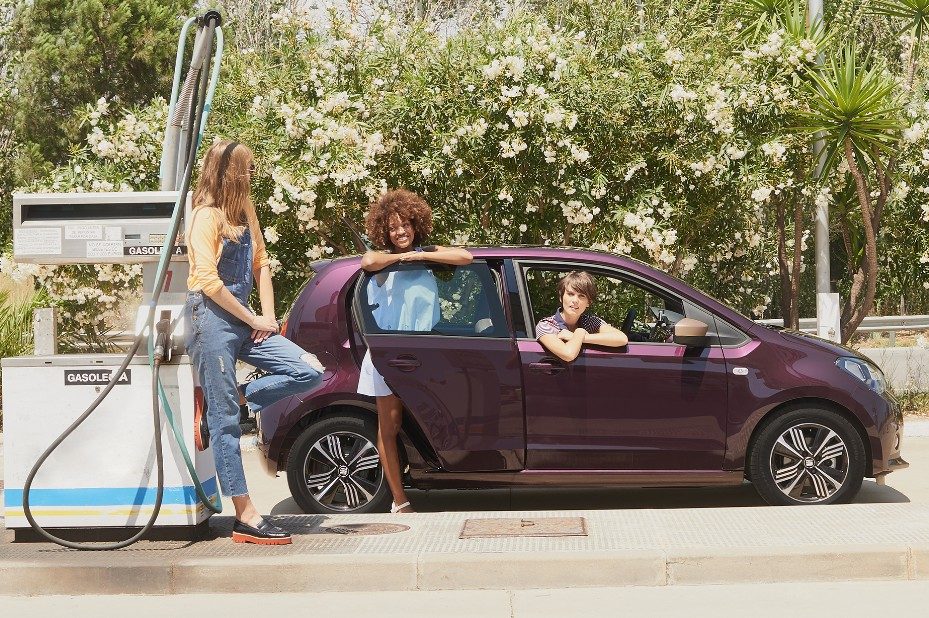
These car manufacturers really need to take a Seat. (Pictured: the Seat Mii)
LONG KNOWN FOR BEING NOT QUITE PRO-WOMEN, Cosmopolitan doubled down on their love of gender norms when they unveiled a car for women at the Cosmpolitan FashFest in London. Designed in coordination with Spanish auto manufacturer Seat and dubbed the Seat Mii, the compact — Ha! — car for women comes with “purple or white exterior paint, champagne colored wing mirrors, headlights with an ‘eyeliner shape,’ jeweled wheels and ease of parking.”
As much as I would love to see advertising that didn’t focus on how sexy, wealthy, and well-endowed cars will allegedly make men seem, the Cosmo car for women is a huge step backward. There’s nothing about a woman’s body or health that makes differently designed vehicles a necessity. We can drive, park, and love any car we choose, even if it doesn’t come with bedazzled hubcaps. To suggest otherwise, as Cosmopolitan has done, is offensive.
We live in a world where everything from snack food to shampoo is unnecessarily gendered. Cosmo isn’t the first to use gender-based marketing to sell a gender-neutral product, and they won’t be the last. Here are seven other needlessly gendered things available today.
1. Bic for Her
Bic’s line of pinkwashed pens for women made headlines in 2012, when Ellen Degeneres revealed on her daytime talk show that the company had asked her to be the face of its new brand. Ellen’s rant went viral, and the pen — designed with a “thin barrel to fit a women’s hand” — became the ultimate, relevant example of everything wrong with gender-based marketing.
I’ve covered the smartphone for women here before, but no list of unnecessarily gendered items would be complete without it. The strange, hamburger-meets-UFO shape and peculiar orange and green design made this product enough of an oddity, and might even have brought in a hipster audience looking for an offering that’s not-too-Luddite. Saying it was designed for women’s hands and needs was just icing on the cake.
3. Hammers and Other Tools
We’ve all seen the pink toolbox — complete with pink-handled hammers, screwdrivers, and pliers — sitting in a friend’s bedroom with the tags still on. That she wanted pink tools doesn’t bother me, but that she paid a significant markup for shoddy “women’s” tools? That one always stings.
You can purchase any home-repair tool in pink these days, even if it requires a drop cord and goes whirr. But, like many pink-taxed items, these gender-marketed tools have few differences from their “male” counterparts, save for an inflated price tag and inferior craftsmanship.
4. Razors, Deodorant, and Other Pink Tax Items
Speaking of the pink tax, I would be remiss if I left toiletries off of this list. Women’s razors, deodorant, soaps, shampoos, and other personal care items are nearly identical to similar products for men, but come at a 20-percent markup.
If you’re aware of the pink tax, and are willing to pay a few dollars more for vanilla- and lavender-scented products, there’s nothing inherently wrong with your choice. If, however, you’d like to stick it to companies that engage in gender-based marketing and discriminatory pricing practices, buy men’s toiletries instead.
5. Ear Plugs
Ears might be an erogenous zone for both sexes, but they’re not a secondary sex characteristic. There’s no reason on earth for companies to produce ear plugs “for women” and “for men,” but that hasn’t stopped them yet. A Google search for “ear plugs for women” finds two major brands, Hearos and Howard Leight, both of which are sold at Amazon. Additionally, Walgreens offers a woman-labeled line of ear plugs from their store brand.
Products like these are marketed as being “soft” and having “rejuvenating” properties, but — unless they come with paid vacation — there’s nothing to suggest that they’re any more or less sleep-inducing than similar offerings for men. Consider ear plugs for women one more unnecessarily gendered thing you can pass on without feeling guilty about it.
6. Candy
Yes, not even candy is safe from aggressive, gender-based marketing. Trader Joe’s offers different “barks” for “cowboys” and “cowgirls.” Mrs Rogers brand sprinkles come in “boys” and “pretty pink” varieties. And, although it’s not technically a candy, there’s the Bronut: definitive evidence that not even dessert is safe from fragile masculinity.
7. Children’s Clothes and Toys
Repeat after me. There is no reason to gender children’s products.
Look, the only question you should be asking yourself when you buy kids’ toys and clothes is: How long will this last before the child outgrows/ruins/breaks it, and is that amount of time worth the price?
The fact is that boys’ clothes, just like men’s, are made from sturdier and warmer materials than girls’ and women’s, due to economic and fashion-culture factors. That doesn’t mean girls’ clothes are bad or worthless, however, and if a child wants to wear a sparkly pink tutu, buy the damn tutu.
















